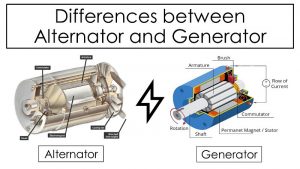If you are a student, then you might have heard the term Alternator and Generator. Both of them are electrical machines that generate electricity. But, if they both have a similar purpose then, why do we have two different names? What are the differences between Alternator and Generator? If you are looking for similar answers, then you just have crashed at the correct place. Because in this article, we will discuss the differences between alternator and generator in detail.
The table given below gives a quick glimpse of the differences between alternator and generator.
| Alternator | Generator |
| An alternator converts the mechanical energy to AC electrical energy. | A generator converts the mechanical energy to either AC or DC electrical energy. |
| In an alternator, the armature remains stationary. | In a generator, the armature is the rotating part. |
| The magnetic field rotates inside the stator periphery. | The magnetic field remains stationary in a generator. |
| Alternators require slip rings to achieve the AC output. | Generators require either slip or split rings, depending on whether the output is AC or DC. |
| The brushes of an alternator last longer than that of a generator. | The brushes of a generator don’t last long and require frequent replacement. |
| An alternator doesn’t require any polarity indication, after its installation. | After the installation, a generator requires a polarity indication. |
| Alternators can work with a transformer to either step up or step down the voltage level. | A DC generator cannot work with a transformer to vary the voltage level. |
| An alternator can produce voltage only when it is required. | Generators can produce voltage at all times. |
| They have a higher output than generators. | They have a lower output as compared to alternators. |
| An alternator conserves more energy than a generator. | A generator conserves less energy than an alternator. |
| The size of an alternator is less than a generator. | The size of a generator is more than an alternator. |
| They have a wide range of RPM (rotations per minute). | They have a low range of RPM (rotations per minute). |
| The overall efficiency of an alternator is more than a generator. | The overall efficiency of a generator is less than an alternator. |
| Alternators cannot charge a dead battery. | Generators can easily charge a dead battery. |
| An alternator is used as a battery charging circuit in modern-day automobiles. | A generator is used for large-scale power generation. |
The table only gives brief information on the differences between alternator and generator. Now it’s time to know the details and catch every concept that you missed in the table.
Definition

Let’s start with the differences between alternator and generator with their definitions. So, an alternator is a device that converts mechanical energy to electrical energy. The nature of this electrical energy is Alternating (AC). On the other hand, a Generator also converts the mechanical energy to electrical, but in this case, the obtained output energy can either be Alternating (AC) or Direct (DC).
Creating Time-varying flux
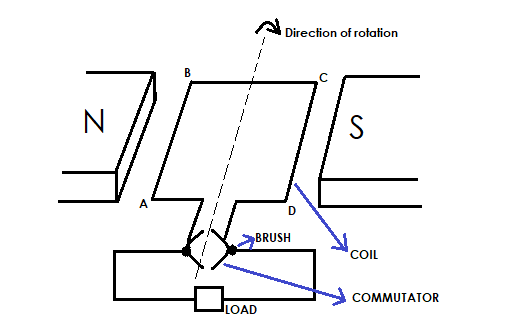
Faraday’s law states that whenever the magnetic flux linking in a circuit changes, an EMF gets induced. The induced EMF is directly proportional to the rate of change of flux linkage.
So, to create a time-varying flux, there must be a relative motion between the conductor and the magnetic field. In electrical machines, we achieve it by keeping either of the ones stationary while rotating the other one.
Armature winding
In the case of an alternator, the armature remains stationary while the armature winding of the generator rotates inside the stator periphery.
Magnetic field
The magnetic field rotates inside the stator periphery in an alternator. On the other hand, the magnetic field in a generator remains stationary to create a magnetic flux linkage.
Rings
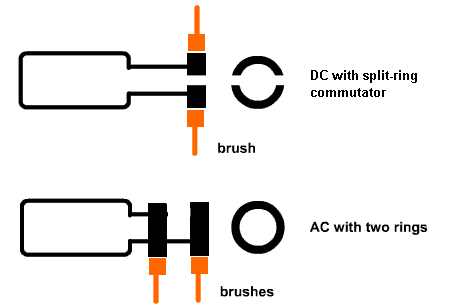
**Image courtesy: Quora
An alternator and a generator use coils of wire inside them. The rotating shaft may also contain these wires. So, while rotating, why do the electrical wires don’t get twisted? Does that thought ever cross your mind? So, to prevent that from happening, metal rings are used.
Depending on the application, a machine may require a complete circular ring (slip ring) or, it may be split axially with adjacent parts insulated from each other (split ring).
As the alternator gives an AC output, it requires the use of slip rings to achieve it.
But, as discussed in the above points, a generator can either give us AC or DC. So, to get an AC output, it requires slip rings while, to get a DC output, it requires split rings.
Brushes
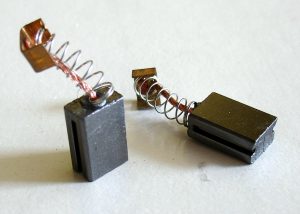
The function of carbon brushes is to create a connecting link between the stationary wires and the rotating shaft. So, the rotating shaft always slides over the carbon brush to maintain an electrical connection. This process creates friction and heat. Hence, the brushes wear out after some time and require replacement.
The brushes of the alternator last longer than that of the generator. As the alternator uses only slip rings, the contact surface is smooth, and the friction is low. But a generator can either use slip or split rings. The split rings are not that uniform resulting in higher wear and tear of the brush.
Polarity indication
An AC has got bi-directional nature. So, the output terminals of an alternator do not require any polarity indication to indicate which terminal is positive or negative. But the DC has a unidirectional nature. So, the output terminal with positive polarity will always remain the same unless the direction of rotation gets changed. So, it becomes necessary to indicate the polarity of the output terminal in a generator if it is supplying DC.
Working with transformers
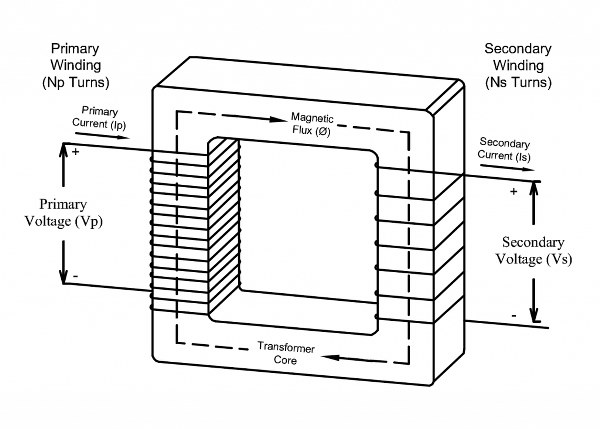
**Image courtesy: The talema group
A transformer is a static device that can either step up or step down the incoming AC voltage.
We can easily connect a transformer after an alternator to step up or step down the AC voltage. But, a transformer cannot work on DC. If we give a DC supply to a transformer, its windings may get damaged. So, in a nutshell, we can’t use a transformer with a generator if it is generating DC.
Voltage generation
We don’t have a way to store AC. That’s why we use an alternator to generate the voltage only when we have to power an electric load. But, in a battery, we can easily store the DC. So, we can use the generator at all times. It can power an electric load as well as charge a battery.
Battery charging
A battery is a group of cells used to power a circuit. It is preferable to use a generator instead of an alternator to charge a dead battery. Because to charge a dead battery, the source must work with 100% capacity. An alternator can only work with that efficiency for a short time. An alternator may get permanently damaged if used for charging a dead battery.
Size
The size of an alternator is smaller than a generator. Hence it is easier to install an alternator in confined places. On the other hand, a generator requires more space for installation.
RPM range
The RPM range of an alternator is more than that of a generator.
Energy conservation
An alternator only uses the required amount of energy, while a generator uses all the produced energy. So an alternator conserves energy more efficiently than a generator.
Efficiency
As the alternator gives a higher output than generators, uses less energy than generators, the overall efficiency of an alternator is greater than the generator.
Uses
Due to its mechanical simplicity, an alternator is used in electric plants to generate electricity on a small scale. The use of an alternator as a battery charging circuit in modern cars is quite common these days.
But to produce electricity on a large scale, it is beneficial to use an AC generator. Moreover, to power DC loads, the only option is to use a DC generator.
So, we hope this might have cleared your doubts on the differences between alternator and generator. If you are still scratching your head, ask your doubt in the comment section below.
